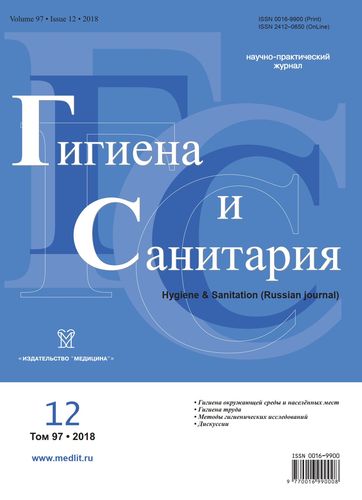Actual hygienic and epidemiological problems of helicobacteriosis
- Authors: Rusakov N.V.1, Bobrovnickiy I.P.1, German S.V.1, Rusakova E.V.2
-
Affiliations:
- Centre for Strategic Planning, Russian Ministry of Health
- National Research Center for Epidemiology and Microbiology named after honorary academician NF Gamalei of the Ministry of Health of Russia
- Issue: Vol 97, No 12 (2018)
- Pages: 1179-1183
- Section: ENVIRONMENTAL HYGIENE
- Published: 21.10.2020
- URL: https://rjsocmed.com/0016-9900/article/view/640473
- DOI: https://doi.org/10.47470/0016-9900-2018-97-12-1179-1183
- ID: 640473
Cite item
Full Text
Abstract
This work is devoted to the problems of hygiene and epidemiology of the Helicobacter pylori infection. In recent years among the causative agents of infectious diseases, Helicobacter pylori (lat. Helicobacter pylori, HP.) takes a special place. Analysis of domestic and foreign literature had shown that at this time there is a high prevalence of Helicobacter infection (HI). It has been diagnosed in almost half of the world’s population. Published data of the Russian researchers point out its high occurrence among the population of Russia (56-88%). Analysis of the annual report of the Federal Service for Supervision in Protection of the Rights of Consumer and Man Wellbeing of the Russian Federation for 2017 showed an effective system of epidemiological and social and hygienic control of HI to have not been developed yet. Considering multiple mechanisms, ways and factors of transmission of the causative agent of HI, directions of scientific researches on the prevention of its distribution are planned. The solution of the hygienic and epidemiological problems of preventing helicobacteriosis can be carried out only by the consolidated participation of specialists of all directions of hygiene and laboratory science, as well as epidemiologists, microbiologists, and public health specialists. Clinical observations and laboratory results suggest a significant role of HP in human pathology: it is an etiological factor of more than half of all gastritis; it is found in more than 95% of patients suffering from duodenal ulcer, in 70-80% of persons with gastric ulcer, and in 60-70% of cases with gastric cancer. Accumulated over last 3 decades data indicates that up to 60-90% of all cases of stomach cancer may be associated with this infection. Against the background of such high numbers of the detection of this pathogen, questions arise why measures of hygienic prevention of Helicobacter pylori have not yet been developed, and scientific institutions of the epidemiological and hygienic profile are not sufficiently puzzled by their development.
About the authors
Nikolay V. Rusakov
Centre for Strategic Planning, Russian Ministry of Health
Author for correspondence.
Email: rusakovnv39@yandex.ru
MD, Ph.D., DSci., Professor, Academician of RAS, an Honored worker of science of Russia. Chief researcher of the Centre for Strategic Planning, Russian Ministry of Health, Moscow, 119991, Russian Federation.
e-mail: rusakovnv39@yandex.ru
Russian FederationI. P. Bobrovnickiy
Centre for Strategic Planning, Russian Ministry of Health
Email: noemail@neicon.ru
Russian Federation
S. V. German
Centre for Strategic Planning, Russian Ministry of Health
Email: noemail@neicon.ru
Russian Federation
E. V. Rusakova
National Research Center for Epidemiology and Microbiology named after honorary academician NF Gamalei of the Ministry of Health of Russia
Email: noemail@neicon.ru
Russian Federation
References
- Cave D. R. How is Helicobacter pylori transmitted? Gastroenterology. 1997; 113 (Suppl.): 9-14
- Marshall B.J., Experimental models in vivo for Campylobacter pylori. Gastroenterol. Clin Biol. 1989: l3: 50-52
- Rakhmanin Yu. A., Herman, S. V. Prevalence and routes of transmission of Helicobacter pylori infection. II. Transmission of infection from external sources (literature Review). Gigiena i sanitarija. 2015; 1: 12-15
- Epidemiology of Helicobacter pylori infection. Pediatric Gastroenterology. Second edition. Ed. by Professor S. V. Belmer and Professor A. I. Khavkin.
- German S. V., Zykova I. E. et al. Epidemiological features of Helicobacter pylori infection in Moscow. Gigiena i sanitarija. 2011;1: 44-48
- International statistical classification of diseases and health-related problems. Tenth revision. Vol. 1-2. WHO. Geneva: 1995
- Rakhmanin Yu. A., Zykova I. E., Fedichkina T. P., Solenova L. G. Approaches to the study of the role of the water factor in the prevalence of Helicobacter pylori infection. Gigiena i sanitarija. 2012; 5: 35-37
- Sotnikov A. N. et al. Chronic erosion of the stomach and Helicobacter pylori infection. EHksperimental’naya i klinicheskaya gastroehnterologiya. 2003; 1: 110.
- Medical Microbiology, Virology and immunology: textbook for medical students. Ed. by A. A. Vorobyov, M.; 2008, 704 p.
- Fedichkina T. P., Solenova L. G., Zykova I. E. On the issue of regulation of Helicobacter pylori in drinking water. Gigiena i sanitarija. 2014; 93 (6): 42-45
- Pasechnikov V. D. Polymerase chain reaction in the diagnosis of H. pylori-associated diseases. Diagnosis and treatment of diseases associated with H. pylori, M; 1998: 8-10
- Fedichkina T. P., Solenovata L. G., Zykova I. E., Herman, S. V., A. V. Modestova, Kislitsin V. A., Rakhmanin Yu.A., Bobrovnitsky I. P. Socio-economic aspects of epidemiology of Helicobacter pylori infection. Gigiena i sanitarija. 2016; 95(9): 861-864
- Zhukhovitskii, V. G. Microbiological diagnosis of Helicobacter pylori infection. EHksperimental’naya i klinicheskaya gastroehnterologiya.2008; 8: 33-44
- Zhukhovitskii, V. G., Gorbachev A. P., Golovkin, B. A., Hidayatova L. A. Serological diagnosis of Helicobacter pylori infection: comparison of analytical possibilities of the three test systems for enzyme immunoassay. Klinicheskaya laboratornaya diagnostika. 2005; 11: 12
- Zhukhovitskii, V. G., Didenko L. V., Konstantinova N. D. The “gold standard” and the algorithm for microbiological diagnosis of Helicobacter pylori infection. Klinicheskaya laboratornaya diagnostika. 2005; 9: 52
- Rakhmanin Yu. A., Zykova I. E., Fedichkina T. P., Solenova L. G., German S. V., Modestova A.V. et al. Study of territorial distribution the division of infection Helicobacter pylori able-bodied on the village of Moscow in the course of the examination of the production contingents’. Gigiena i sanitarija. 2013; 5: 79-82.
- Senchikhin K. P., Filin V. A., Chelnokov M. M. et al. Epidemiology of Helicobacter pylori infection family. Rossijskij zhurnal gastroehnterologii, gepatologii i koloproktologii. 1997; 5. (Annex 4): 206.
Supplementary files









